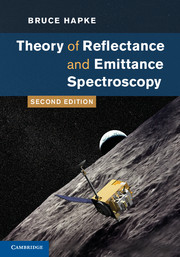Book contents
- Frontmatter
- Contents
- Acknowledgments
- 1 Introduction
- 2 Electromagnetic wave propagation
- 3 The absorption of light
- 4 Specular reflection
- 5 Single-particle scattering: perfect spheres
- 6 Single-particle scattering: irregular particles
- 7 Propagation in a nonuniform medium: the equation of radiative transfer
- 8 The bidirectional reflectance of a semi-infinite medium
- 9 The opposition effect
- 10 A miscellany of bidirectional reflectances and related quantities
- 11 Integrated reflectances and planetary photometry
- 12 Photometric effects of large-scale roughness
- 13 Polarization of light scattered by a particulate medium
- 14 Reflectance spectroscopy
- 15 Thermal emission and emittance spectroscopy
- 16 Simultaneous transport of energy by radiation and thermal conduction
- Appendix A A brief review of vector calculus
- Appendix B Functions of a complex variable
- Appendix C The wave equation in spherical coordinates
- Appendix D Fraunhofer diffraction by a circular hole
- Appendix E Table of symbols
- Bibliography
- Index
13 - Polarization of light scattered by a particulate medium
Published online by Cambridge University Press: 05 January 2012
- Frontmatter
- Contents
- Acknowledgments
- 1 Introduction
- 2 Electromagnetic wave propagation
- 3 The absorption of light
- 4 Specular reflection
- 5 Single-particle scattering: perfect spheres
- 6 Single-particle scattering: irregular particles
- 7 Propagation in a nonuniform medium: the equation of radiative transfer
- 8 The bidirectional reflectance of a semi-infinite medium
- 9 The opposition effect
- 10 A miscellany of bidirectional reflectances and related quantities
- 11 Integrated reflectances and planetary photometry
- 12 Photometric effects of large-scale roughness
- 13 Polarization of light scattered by a particulate medium
- 14 Reflectance spectroscopy
- 15 Thermal emission and emittance spectroscopy
- 16 Simultaneous transport of energy by radiation and thermal conduction
- Appendix A A brief review of vector calculus
- Appendix B Functions of a complex variable
- Appendix C The wave equation in spherical coordinates
- Appendix D Fraunhofer diffraction by a circular hole
- Appendix E Table of symbols
- Bibliography
- Index
Summary
Introduction
In the radiative-transport equations for the reflectance and emittance of a particulate medium developed in Chapter 7 it was assumed that polarization can be neglected. For irregular particles that are large compared with the wavelength of the observation, this assumption is justified on the grounds that the light scattered by such particles is relatively weakly polarized (e.g., Figure 6.7b). However, even though it may be small, the polarization of the light scattered by a medium does contain information about the medium and, thus, is potentially a useful tool for remote sensing. One of the advantages of using polarization is that it does not require absolute calibration of the detector, but only a measurement of the ratio of two radiances.
The discovery that sunlight scattered from a planetary regolith was polarized was made as early as 1811 by Arago, who noticed that moonlight was partially linearly polarized and that the dark lunar maria were more strongly polarized than the lighter highlands. Subsequent observations of planetary polarization were made by several persons, including Lord Rosse in Ireland. However, the quantitative measurement of polarization from bodies of the solar system was placed on a firm foundation in the 1920s by the classical studies of Lyot (1929). This work was later continued by Dollfus (1956, 1998) and his colleagues. For a more detailed historical account, the reviews by Dollfus (1961, 1962) and Gehrels (1974) should be consulted.
- Type
- Chapter
- Information
- Theory of Reflectance and Emittance Spectroscopy , pp. 339 - 368Publisher: Cambridge University PressPrint publication year: 2012

